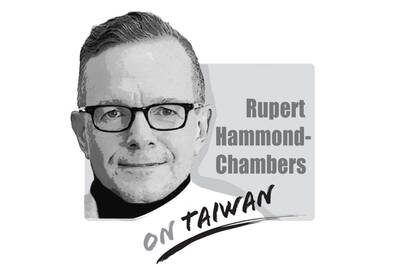Last month, President Ma Ying-jeou (馬英九) spoke of his “six discourses for the nation” (六國論) on his second anniversary in office. He envisioned Taiwan embarking on a “golden decade” focusing on innovation, culture, the environment, constitutional governance, social welfare and peace. But will his focus on environmental issues and the government’s perennial promises about energy conservation and carbon emission reductions actually steer Taiwan in a new direction?
This year’s presidential proclamation proudly states that carbon emissions will be reduced to 2000 levels by 2025. This, however, is less impressive than a resolution passed during the 1998 First National Energy Conference, which stated that carbon emissions were to be reduced to 2000 levels by 2020.
The presidential proclamation also said that Taiwan’s emissions in 2008 represented a 4.4 percent reduction from those in 2007 and that energy efficiency had risen by 3.6 percent, thanks to government policies. According to the International Energy Agency’s World Energy Outlook last year, the global economic downturn has led to a considerable decline in energy consumption, so much so that overall global carbon emissions fell in 2008 by 2 billion tonnes, or 6 to 7 percent, from the previous year. In other words, Taiwan’s 4 percent fall in emissions during that same period is much less than the global average. Also, the 2008 reduction derived predominantly from international factors. Not only should the government not be taking credit for the reduction, it should be investigating whether excessive energy consumption by industry accounts for the fact that emissions have been reduced less in Taiwan than in other countries.
Despite the current preoccupation with cutting emissions, the government is still pushing for the expansion of energy intensive industries. Take Formosa Plastics’ controversial expansion of its sixth naphtha cracker plant, phase five of which is currently under review, compared with the new Kuokuang Petrochemical plant. The latter is of comparable scale, but according to an environmental impact assessment (EIA) report, its annual carbon emissions would be a quarter to a fifth that of the Formosa Plastics plant. These two plants alone could increase annual emissions by 40 or 50 million tonnes if approved, emissions equivalent to those created by 7 million or 8 million Taiwanese. It’s as if the government is asking the public to conserve energy just so they can offset the huge energy consumption of these industries.
In many recent cases the Environmental Protection Administration (EPA) has ruled in favor of large corporations and against the public. The Supreme Administrative Court revoked EIA originally approved in 2006 for the Cising Plant in the Central Taiwan Science Park, causing the EPA to express bafflement and accuse the court of deliberately misinterpreting the Environmental Impact Assessment Act (環境影響評估法).
Formosa Plastics’ Renwu Plant has recently been found guilty of seriously polluting the local soil and groundwater and in some cases these pollutants have been around 300,000 times official limits. The EPA, however, will not countenance the suspension of work. We hear nothing of the repeated protests of civil groups against the high levels of arsenic in the air around the Hsinchu and Central Science Parks and no company or individual has ever been punished.
President Ma seems to have forgotten what environmental protection means.
Gloria Hsu is a professor in National Taiwan University’s Department of Atmospheric Sciences and former chairwoman of the Taiwan Environmental Protection Union.
TRANSLATED BY PAUL COOPER

In the past month, two important developments are poised to equip Taiwan with expanded capabilities to play foreign policy offense in an age where Taiwan’s diplomatic space is seriously constricted by a hegemonic Beijing. Taiwan Foreign Minister Lin Chia-lung (林佳龍) led a delegation of Taiwan and US companies to the Philippines to promote trilateral economic cooperation between the three countries. Additionally, in the past two weeks, Taiwan has placed chip export controls on South Africa in an escalating standoff over the placing of its diplomatic mission in Pretoria, causing the South Africans to pause and ask for consultations to resolve
An altercation involving a 73-year-old woman and a younger person broke out on a Taipei MRT train last week, with videos of the incident going viral online, sparking wide discussions about the controversial priority seats and social norms. In the video, the elderly woman, surnamed Tseng (曾), approached a passenger in a priority seat and demanded that she get up, and after she refused, she swung her bag, hitting her on the knees and calves several times. In return, the commuter asked a nearby passenger to hold her bag, stood up and kicked Tseng, causing her to fall backward and
In December 1937, Japanese troops captured Nanjing and unleashed one of the darkest chapters of the 20th century. Over six weeks, hundreds of thousands were slaughtered and women were raped on a scale that still defies comprehension. Across Asia, the Japanese occupation left deep scars. Singapore, Malaya, the Philippines and much of China endured terror, forced labor and massacres. My own grandfather was tortured by the Japanese in Singapore. His wife, traumatized beyond recovery, lived the rest of her life in silence and breakdown. These stories are real, not abstract history. Here is the irony: Mao Zedong (毛澤東) himself once told visiting
When I reminded my 83-year-old mother on Wednesday that it was the 76th anniversary of the founding of the People’s Republic of China, she replied: “Yes, it was the day when my family was broken.” That answer captures the paradox of modern China. To most Chinese in mainland China, Oct. 1 is a day of pride — a celebration of national strength, prosperity and global stature. However, on a deeper level, it is also a reminder to many of the families shattered, the freedoms extinguished and the lives sacrificed on the road here. Seventy-six years ago, Chinese Communist leader Mao Zedong (毛澤東)